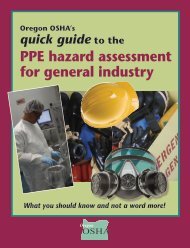Technical Manual - Section 3 (Safety Hazards)
Technical Manual - Section 3 (Safety Hazards)
Technical Manual - Section 3 (Safety Hazards)
Create successful ePaper yourself
Turn your PDF publications into a flip-book with our unique Google optimized e-Paper software.
chemicals and other hazards such as noise and heat; during<br />
process sampling, inspection, maintenance, and turnaround<br />
activities; and when handling amine or exposed to catalyst.<br />
ISOMERIZATION<br />
Isomerization converts n-butane, n-pentane and n-hexane into<br />
their respective isoparaffins of substantially higher octane<br />
number. The straight-chain paraffins are converted to their<br />
branched-chain counterparts whose component atoms are the<br />
same but are arranged in a different geometric structure.<br />
Isomerization is important for the conversion of n-butane into<br />
isobutane, to provide additional feedstock for alkylation units,<br />
and the conversion of normal pentanes and hexanes into<br />
higher branched isomers for gasoline blending. Isomerization<br />
is similar to catalytic reforming in that the hydrocarbon<br />
molecules are rearranged, but unlike catalytic reforming,<br />
isomerization just converts normal paraffins to isoparaffins.<br />
There are two distinct isomerization processes, butane (C 4 )<br />
and pentane/hexane (C 5 /C 6 ). Butane isomerization produces<br />
feedstock for alkylation. Aluminum chloride catalyst plus<br />
hydrogen chloride are universally used for the<br />
low-temperature processes. Platinum or another metal<br />
catalyst is used for the higher-temperature processes. In a<br />
typical low-temperature process, the feed to the isomerization<br />
plant is n-butane or mixed butanes mixed with hydrogen (to<br />
inhibit olefin formation) and passed to the reactor at 230-340º<br />
F and 200-300 psi. Hydrogen is flashed off in a<br />
high-pressure separator and the hydrogen chloride removed<br />
in a stripper column. The resultant butane<br />
mixture is sent to a fractionator (deisobutanizer) to separate<br />
n-butane from the isobutane product.<br />
Pentane/hexane isomerization increases the octane number<br />
of the light gasoline components n-pentane and n-hexane,<br />
which are found in abundance in straight-run gasoline. In a<br />
typical C5/C6 isomerization process, dried and desulfurized<br />
feedstock is mixed with a small amount of organic chloride<br />
and recycled hydrogen, and then heated to reactor<br />
temperature. It is then passed over supported-metal catalyst<br />
in the first reactor where benzene and olefins are<br />
hydrogenated. The feed next goes to the isomerization reactor<br />
where the paraffins are catalytically isomerized to<br />
isoparaffins. The reactor effluent is then cooled and<br />
subsequently separated in the product separator into two<br />
streams: a liquid product (isomerate) and a recycle<br />
hydrogen-gas stream. The isomerate is washed (caustic and<br />
water), acid stripped, and stabilized before going to storage.<br />
SAFETY AND HEALTH CONSIDERATIONS<br />
Fire Protection and Prevention<br />
Although this is a closed process, the potential for a fire<br />
exists should a release or leak contact a source of ignition<br />
such as the heater.<br />
<strong>Safety</strong><br />
If the feedstock is not completely dried and desulfurized, the<br />
potential exists for acid formation leading to catalyst<br />
poisoning and metal corrosion. Water or steam must not be<br />
allowed to enter areas where hydrogen chloride is present.<br />
Precautions are<br />
Table III:2-15 ISOMERIZATION PROCESSES<br />
Feedstock From Process Typical products................To<br />
n-Butane Various Rearrangement Isobutane.........................Alkylation<br />
n-Pentane processes Isopentane........................Blending<br />
n-Hexane Isohexane.........................Blending<br />
Gas.................................Gas Plant<br />
III:2-35
















